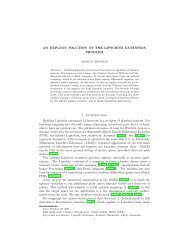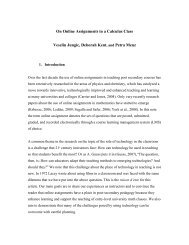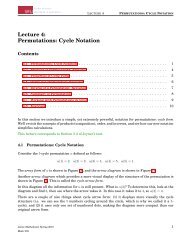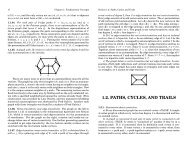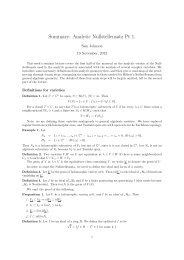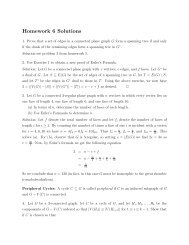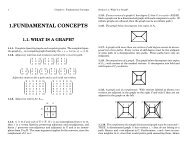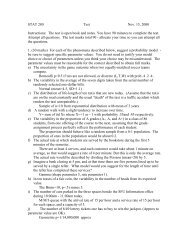March 12 - People.stat.sfu.ca
March 12 - People.stat.sfu.ca
March 12 - People.stat.sfu.ca
You also want an ePaper? Increase the reach of your titles
YUMPU automatically turns print PDFs into web optimized ePapers that Google loves.
Math 821, Spring 2013, Lecture 15<br />
1 Partitions<br />
Karen Yeats<br />
(Scribe: Avery Beardmore)<br />
<strong>March</strong> <strong>12</strong>, 2013<br />
Definition 1. A partition of n is λ = (λ1 ≥ . . . ≥ λk) such that λ1 + . . . +<br />
λk = n, where<br />
• n is the size of λ<br />
• k is the number of parts<br />
Write k(λ) for the number of parts of λ.<br />
We’ve already discussed Ferrers diagrams, as well as Durfee squares and the<br />
conjugate position where λ is the conjugate of λ:<br />
Example 1. λ = (6, 5, 5, 3, 2, 2, 1)<br />
fig. 1<br />
Durfee Square<br />
Definition 2. Let λ = (λ1 ≥ . . . ≥ λk) be a partition. Let F be its Ferrers<br />
diagram viewed with the top left corner’s coordinates at (0, 0). Let F be F<br />
after reflecting in y = −x. Then the partition λ corresponding to P is the<br />
conjugate of λ<br />
Example 2. With the previous example for λ, λ = (7, 6, 4, 3, 3, 1).<br />
Some specifi<strong>ca</strong>tions for partitions:<br />
P =<br />
∞<br />
Seq(Z j )<br />
j=1<br />
1
P = MSet(I) I = Seq≥1(Z)<br />
∞ <br />
P = Z k2<br />
⎛<br />
∞<br />
× ⎝ Seq(Z j ⎞<br />
) ⎠<br />
k=1<br />
2 Identities and Bijections<br />
j=1<br />
A classic problem you may have seen before:<br />
Proposition 1. The number of partitions of size n with distinct parts equals<br />
the number of partitions of size n with odd parts.<br />
Proof. Let D be the combinatorial class of partitions with distinct parts.<br />
Let Po be the combinatorial class of partitions with odd parts.<br />
j=1<br />
∞<br />
D = (E + Z j ∞<br />
) D(x) = (1 + x j )<br />
j=1<br />
j=1<br />
j=1<br />
∞<br />
Po = Seq(Z 2j−1 ∞ 1<br />
) Po(x) =<br />
1 − x2j−1 ∞<br />
D(x) = (1 + x j ∞<br />
)<br />
j=1<br />
1 − xj =<br />
1 − xj ∞<br />
j=1<br />
j=1<br />
1 − x2j =<br />
1 − xj ∞<br />
j=1<br />
Proposition 2 (Euler’s pentagonal number theorem).<br />
∞<br />
(1 − x j ) =<br />
j=1<br />
∞<br />
h=−∞<br />
(−1) h x h(3h−1)<br />
2<br />
2<br />
1<br />
= Po(x)<br />
1 − x2j−1 Before we prove this, what does it have to do with pentagonal numbers?<br />
Pentagonal numbers summarize the ”size” of pentagons:<br />
1 2 3<br />
fig. 2<br />
2
To simplify summing, here’s a trick:<br />
fig. 3<br />
We want a formula for these numbers. Pentagonal numbers are given by the<br />
formula<br />
h 2 h(h − 1)<br />
+ =<br />
2<br />
3h2 − h<br />
2<br />
which appears as the power of x.<br />
Proof. First rewrite the result:<br />
∞<br />
(1 − x j ∞<br />
) = 1 + (−1)<br />
j=1<br />
h=1<br />
h <br />
x h(3h−1)<br />
2 + x h(3h+1)<br />
2<br />
Now let’s interpret these combinatorially. We’ll use D again. Let D(x, y)<br />
be the bivariate generating function for D.<br />
D(x, y) = <br />
x |λ| y k(λ)<br />
Then<br />
D(x, y) =<br />
λ∈D<br />
∞<br />
(1 + x j y)<br />
j=1<br />
So D(x, −1) is the left hand side of the proposition.<br />
Furthermore,<br />
where<br />
D(x, −1) =<br />
∞<br />
n=1<br />
(de,n − do,n)x n<br />
• de,n is the number of elements of Dn with an even number of parts<br />
• do,n is the number of elements of Dn with an odd number of parts<br />
Now let’s define some more parameters for partitions. x(λ) = λ k(λ) = the<br />
smallest part corresponds to the boxes in the last row of the Ferrers diagram.<br />
Mark them on the Ferrers diagram with an x.<br />
3
fig. 4<br />
O(λ) = max{c : λ1 + 1 − c = λc}, which is the number of boxes in the<br />
rightmost reverse diagonal of the Ferrers diagram.<br />
Now we want to build an involution ψ : D → D with the following properties:<br />
• |ψ(λ)| = |λ| ∀λ ∈ D<br />
• either ψ(λ) = λ or |k(λ) − k(ψ(λ))| = 1 ∀λ ∈ D<br />
• ψ(ψ(λ)) = λ ∀λ ∈ D<br />
Assuming we have such a ψ, let<br />
Then<br />
=<br />
∞<br />
n=1<br />
fe,n = |{λ ∈ Dn : k(λ) even, ψ(λ) = λ}|<br />
fo,n = |{λ ∈ Dn : k(λ) odd, ψ(λ) = λ}|<br />
D(x, −1) =<br />
(fe,n − fo,n)x n +<br />
∞<br />
n=1<br />
but applying ψ to that equation we get<br />
D(x, −1) =<br />
∞<br />
n=1<br />
(fe,n − fo,n)x n +<br />
(de,n − do,n)x n<br />
<br />
λ∈D, |k(λ)−k(ψ(λ))|=1<br />
<br />
λ∈D, |k(λ)−k(ψ(λ))|=1<br />
x λ (−1) k(λ)<br />
x ψ(λ) (−1) k(ψ(λ))<br />
Then by ψ, the last term of the second equation is the negative of the last<br />
term of the first equation. Thus, they are each zero.<br />
Next, build ψ: take λ ∈ D<br />
• (a) If x(λ) ≥ o(λ)+2, then remove the o boxes, including any box with<br />
both x and o. Append them as a new row. The result is the Ferrers<br />
diagram of a partition with distinct parts, since after removing the o<br />
boxes, we still have at least o(λ) + 1 boxes in the last row, so we <strong>ca</strong>n<br />
add the o’s as a new row remaining distinct.<br />
• (b) If x(λ) = o(λ) + 1 and there is no box with both x and o, then do<br />
as in part (a) and we still get a partition with distinct parts.<br />
4
• (c) If x(λ) = o(λ) + 1 and there is a box with both x and o, then<br />
ψ(λ) = λ.<br />
• (d) If o(λ) > x(λ), remove the x boxes including any x,o box and<br />
append one to the end of the first x(λ) rows. This gives a partition<br />
with distinct parts and furthermore each x is appended immediately<br />
following an o.<br />
• (e) If o(λ) = x(λ) and there’s no box with both x and o, then do as<br />
in (d) and get the same result.<br />
• (f) If o(λ) = x(λ) and there is an x,o box, then ψ(λ) = λ.<br />
Now we need to check ψ has the properties it’s supposed to have. As we<br />
constructed it, we checked ψ : D → D. Also, |ψ(λ)| = |λ| be<strong>ca</strong>use we only<br />
move boxes, never add or remove them.<br />
• In (c) and (f), ψ(λ) = λ.<br />
• In (a) and (b), k(λ) = k(ψ(λ)) − 1<br />
• In (d) and (e), k(λ) = k(ψ(λ)) + 1<br />
giving the second property of ψ.<br />
If ψ is in (c) or (f), then so is ψ, so ψ(ψ(λ)) = λ.<br />
If λ is in (a) or (b),<br />
x(ψ(λ)) = o(λ)<br />
o(ψ(λ)) ≥ o(λ)<br />
if equal, there’s no x,o box so we’re in the <strong>ca</strong>se (d) or (e) for ψ(λ). So<br />
ψ(ψ(λ)) just places the boxes back.<br />
Similarly, if λ is in (d) or (e),<br />
x(ψ(λ)) > x(λ)<br />
(strictly greater due to distinct parts.)<br />
o(ψ(λ)) = x(λ)<br />
if x(ψ(λ)) = x(λ) + 1, then we didn’t add an extra box to this row, so no<br />
x,o box in ψ(λ). Thus we’re in (a) or (b), and so ψ(ψ(λ)) places the boxes<br />
back in their original places.<br />
5
So<br />
D(x, −1) =<br />
<br />
λ∈D,ψ(λ)=λ<br />
x |λ| (−1) k(λ) =<br />
∞<br />
(1 − x j )<br />
So what are the fixed points of ψ? They must have an x,o box and either<br />
o(λ) = x(λ) or x(λ) = o(λ) + 1.<br />
So the size must be k 2 + k(k−1)<br />
2<br />
OR<br />
fig. 5<br />
k(3k−1)<br />
= 2<br />
j=1<br />
or k 2 + k(k−1)<br />
2<br />
k(3k+1)<br />
= 2<br />
except if k = 0, then there is just E contributing a 1. So we get the desired<br />
formula.<br />
3 References<br />
Yeats’ personal notes.<br />
6




